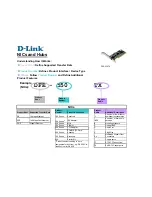
C
HAPTER
16
| Multicast Filtering
Layer 2 IGMP (Snooping and Query)
– 418 –
ES-4500G Series
◆
Proxy Reporting Status
– Enables IGMP Snooping with Proxy
Reporting. (Default: Disabled)
When proxy reporting is enabled with this command, the switch
performs “IGMP Snooping with Proxy Reporting” (as defined in DSL
Forum TR-101, April 2006), including last leave, and query
suppression.
Last leave sends out a proxy query when the last member leaves a
multicast group, and query suppression means that neither specific
queries nor general queries are forwarded from an upstream multicast
router to hosts downstream from this device.
◆
TCN Flood
– Enables flooding of multicast traffic if a spanning tree
topology change notification (TCN) occurs. (Default: Disabled)
When a spanning tree topology change occurs, the multicast
membership information learned by switch may be out of date. For
example, a host linked to one port before the topology change (TC)
may be moved to another port after the change. To ensure that
multicast data is delivered to all receivers, by default, a switch in a
VLAN (with IGMP snooping enabled) that receives a Bridge Protocol
Data Unit (BPDU) with TC bit set (by the root bridge) will enter into
“multicast flooding mode” for a period of time until the topology has
stabilized and the new locations of all multicast receivers are learned.
If a topology change notification (TCN) is received, and all the uplink
ports are subsequently deleted, a time out mechanism is used to delete
all of the currently learned multicast channels.
When a new uplink port starts up, the switch sends unsolicited reports
for all currently learned channels out the new uplink port.
By default, the switch immediately enters into “multicast flooding
mode” when a spanning tree topology change occurs. In this mode,
multicast traffic will be flooded to all VLAN ports. If many ports have
subscribed to different multicast groups, flooding may cause excessive
packet loss on the link between the switch and the end host. Flooding
may be disabled to avoid this, causing multicast traffic to be delivered
only to those ports on which multicast group members have been
learned. Otherwise, the time spent in flooding mode can be manually
configured to reduce excessive loading.
When the spanning tree topology changes, the root bridge sends a
proxy query to quickly re-learn the host membership/port relations for
multicast channels. The root bridge also sends an unsolicited Multicast
Router Discover (MRD) request to quickly locate the multicast routers in
this VLAN.
The proxy query and unsolicited MRD request are flooded to all VLAN
ports except for the receiving port when the switch receives such
packets.
◆
TCN Query Solicit
– Sends out an IGMP general query solicitation
when a spanning tree topology change notification (TCN) occurs.
(Default: Disabled)
When the root bridge in a spanning tree receives a TCN for a VLAN
where IGMP snooping is enabled, it issues a global IGMP leave message
Summary of Contents for iPECS ES-4526G
Page 1: ...USER GUIDE User Manual ES 4550G ES 4526G Managed Layer 3 Stackable GE Switch ...
Page 38: ...CONTENTS 38 ES 4500G Series ...
Page 58: ...SECTION I Getting Started 58 ES 4500G Series ...
Page 70: ...CHAPTER 1 Introduction System Defaults 70 ES 4500G Series ...
Page 86: ...SECTION I Web Configuration 86 ES 4500G Series Multicast Filtering on page 413 ...
Page 196: ...CHAPTER 6 VLAN Configuration Configuring MAC based VLANs 196 ES 4500G Series ...
Page 204: ...CHAPTER 7 Address Table Settings Clearing the Dynamic Address Table 204 ES 4500G Series ...
Page 228: ...CHAPTER 8 Spanning Tree Algorithm Configuring Interface Settings for MSTP 228 ES 4500G Series ...
Page 230: ...CHAPTER 9 Rate Limit Configuration 230 ES 4500G Series Figure 106 Configuring Rate Limits ...
Page 260: ...CHAPTER 12 Quality of Service Attaching a Policy Map to a Port 260 ES 4500G Series ...
Page 478: ...CHAPTER 17 IP Configuration Setting the Switch s IP Address IP Version 6 478 ES 4500G Series ...
Page 528: ...CHAPTER 20 IP Services Forwarding UDP Service Requests 528 ES 4500G Series ...
Page 614: ...CHAPTER 22 Multicast Routing Configuring PIMv6 for IPv6 614 ES 4500G Series ...
Page 628: ...CHAPTER 23 Using the Command Line Interface CLI Command Groups 628 ES 4500G Series ...
Page 702: ...CHAPTER 26 SNMP Commands 702 ES 4500G Series ...
Page 710: ...CHAPTER 27 Remote Monitoring Commands 710 ES 4500G Series ...
Page 868: ...CHAPTER 34 Port Mirroring Commands Local Port Mirroring Commands 868 ES 4500G Series ...
Page 890: ...CHAPTER 37 Address Table Commands 890 ES 4500G Series ...
Page 1066: ...CHAPTER 43 LLDP Commands 1066 ES 4500G Series ...
Page 1076: ...CHAPTER 44 Domain Name Service Commands 1076 ES 4500G Series ...
Page 1286: ...CHAPTER 49 Multicast Routing Commands PIM Multicast Routing 1286 ES 4500G Series ...
Page 1288: ...SECTION I Appendices 1288 ES 4500G Series ...
Page 1294: ...APPENDIX A Software Specifications Management Information Bases 1294 ES 4500G Series ...
Page 1327: ...ES 4526G ES 4550G E042011 ST R01 150200000149A ...
Page 1328: ...APRIL 2011 ISSUE 1 0 ...
















































